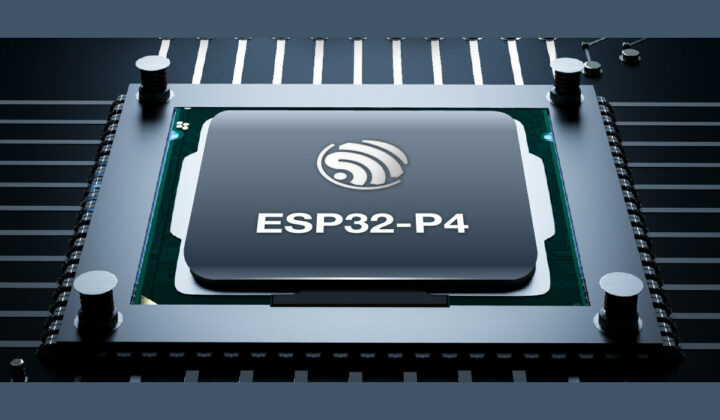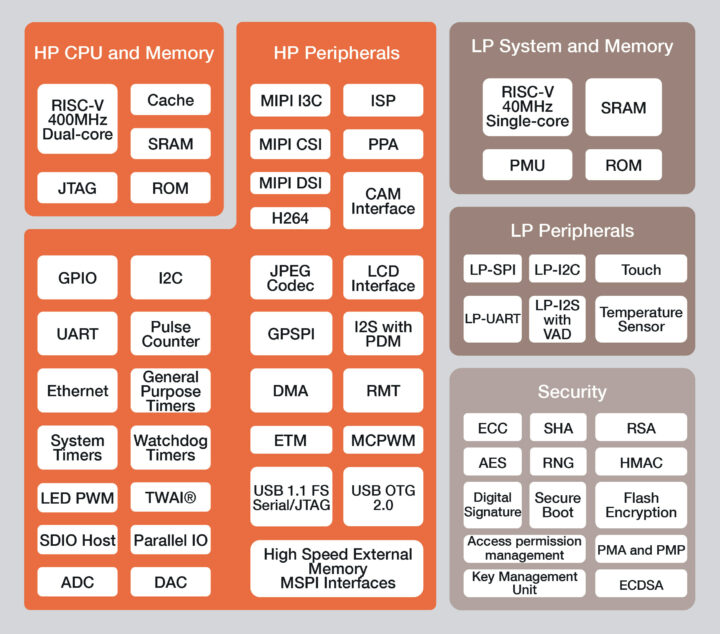Espressif ESP32-P4 is a general-purpose dual-core RISC-V microcontroller clocked at up to 400 MHz with AI instructions extension, numerous I/Os, and security features.
It also happens to be the first microcontroller from Espressif Systems without wireless connectivity, and as such, it should probably be seen as an alternative to STM32F7/H7 or NXP i.RT Arm Cortex-M7 microcontrollers/crossover processors, and likely offered at a significantly lower cost. It should also offer lower power consumption than other ESP32 chips thanks in part to a third RISC-V core clocked at 40 MHz that can keep the system running while the other two high-performance cores are down.
ESP32-P4 key features and specifications:
- MCU subsystems
- Dual-core RISC-V HP (High-performance) CPU @ up to 400 MHz with AI instructions extension and single-precision FPU, 768KB of on-chip SRAM
- Single-RISC-V LP (Low-power) MCU core @ up to 40 MHz with 8KB of zero-wait TCM RAM
- Memory & Storage I/F – Support for external PSRAM and flash
- GPU – 2D Pixel Processing Accelerator (PPA)
- VPU – H.264 and JPEG codecs support
- HP peripherals
- Display I/F – MIPI DSI and parallel LCD display interface
- Camera I/F – MIPI-CSI with integrated ISP and parallel camera interface
- Audio – I2S with PDM
- Networking – Ethernet
- USB – USB OTG 2.0 HS, USB 1.1 FS Serial/JTAG
- SPI, I2C, I3C, LED PWM, MCPWM, RMT, UART, and TWAI
- ADC, DAC
- SDIO Host 3.0 for high-speed connectivity.
- Up to 50x GPIOs
- General-purpose timers, watchdog timers, system timers
- LP peripherals
- SPI, UART, I2C
- I2S with VAD (for wake word detection)
- Touch control
- Temperature sensor
- Security
- Secure Boot
- Flash Encryption
- Cryptographic accelerators for ECC, SHA, AES, RSA, ECDSA
- TRNG
- Digital Signature Peripheral
- Dedicated Key Management Unit
- Access permission management
- PMA and PMP
As noted in the second paragraph the “big-little” architecture will enable ultra-low-power applications which may occasionally require high computing with the HP cores turned off for most of the time in order to save power. Support for 2D graphics acceleration, H.264 & JPEG codecs will make it suitable for human-machine interfaces with machine learning capability and the requirements for a larger number of I/O are made available by current ESP32 chips.
It’s still possible to add wireless connectivity to the ESP32-P4 with one of the ESP-Hosted or ESP-AT solutions, where the ESP32-P4 acts as a host MCU and the other ESP32 chip provides WiFi, Bluetooth, or Zigbee. Espressif will support the new ESP32-P4 through the usual ESP-IDF framework. The new RISC-V microcontroller is not available just yet, but the company tells us to stay tuned for more detailed information in the coming weeks.
Thanks to Adam for the tip.

Jean-Luc started CNX Software in 2010 as a part-time endeavor, before quitting his job as a software engineering manager, and starting to write daily news, and reviews full time later in 2011.
Support CNX Software! Donate via cryptocurrencies, become a Patron on Patreon, or purchase goods on Amazon or Aliexpress






